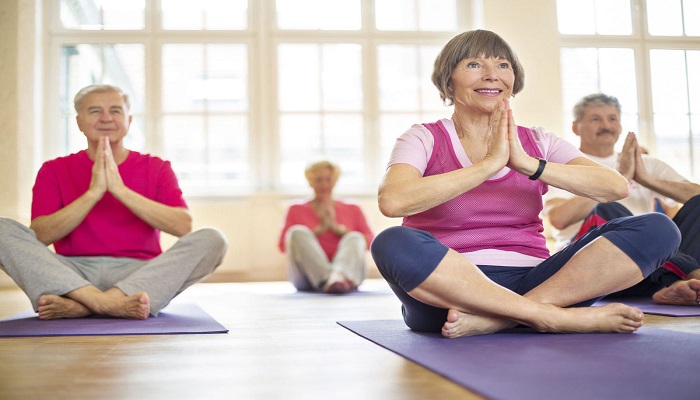
Cleanse your body and mind of negative thoughts and toxins through yoga. Here is a simple yoga pose to try.
Side Plank Pose
A powerful arm and wrist strengthener, Side Plank takes its two-armed sibling to the next level, as an arm balance.
The full version of Vasisthasana, as taught by BKS Iyengar, with the top leg raised perpendicular to the floor, is beyond the capacity of most beginners. The pose described here is a modified version suitable for all levels of students.
(vah-sish-TAHS-anna)
Vasistha = literally means “most excellent, best, richest.” Vasistha is the name of several well-known sages in the yoga tradition. There’s a Vasistha numbered among the seven (sometimes 10 or 12) seers (rishis) or lords of creation (prajapatis), and a Vasistha who’s author of a number of Vedic hymns. He’s also said to be the owner of the fabulous “cow of plenty,” Nandini (“delight”), which grants his every wish and accounts for his infinite wealth.
Side Plank Pose: Step-by-Step Instructions

Step 1
Perform Adho Mukha Svanasana. Shift onto the outside edge of your left foot, and stack your right foot on top of the left. Now swing your right hand onto your right hip, turn your torso to the right as you do, and support the weight of your body on the outer left foot and left hand.
Step 2
Make sure that the supporting hand isn’t directly below its shoulder; position the hand slightly in front of its shoulder, so the supporting arm is angled a bit relative to the floor. Straighten the arm by firming the triceps muscle, and press the base of the index finger firmly against the floor.
Step 3
Firm the scapulas and sacrum against the back torso. Strengthen the thighs, and press through the heels toward the floor. Align your entire body into one long diagonal line from the heels to the crown.
Step 4
If you’d like you can stretch the top arm toward the ceiling, parallel to the line of the shoulders. Keep the head in a neutral position, or turn it to gaze up at the top hand.
Step 5
Stay in this position for 15 to 30 seconds. Come back to Adho Mukha Svanasana, take a few breaths, and repeat to the right side for the same length of time. Then return to Adho Mukha Svanasana for a few more breaths, and finally release into Balasana.
Pose Information
Sanskrit Name
Vasisthasana
Pose Level: 1
Contraindications and Cautions
Students with serious wrist, elbow, or shoulder injuries should avoid this pose.
Modifications and Props
In order to increase the strength and stability of this pose, it’s helpful to work it with your soles pressing against a wall. Perform Adho Mukha Svanasana with your heels up on a wall, the balls of your feet on the floor. When you shift onto the outside of your left foot, press the sole against the wall. Similarly, when you stack your right foot on top of the left, press that sole to the wall. Then in the pose, push your heels actively into the wall.
Preparatory Poses
Adho Mukha Svanasana
Ardha Chandrasana
Plank Pose
Prasarita Padottanasana
Supta Padangusthasana (for the full version)
Supta Virasana
Follow-up Poses
Vasisthasana is typically (in the Iyengar system) the first in a series of three “one-arm” balancing positions. The two companion poses in this series are usually beyond the skill level of the beginning student. You might follow this version of Vasisthasana with any of the standing poses that press the bottom hand to the floor (like Utthita Parsvakonasanaand Utthita Trikonasana) or:
Adho Mukha Vrksasana
Adho Mukha Svanasana
Chaturanga Dandasana
Pincha Mayurasana
Salamba Sirsasana
Virabhadrasana II
Beginner’s Tip
Beginners often have a difficult time sustaining this pose, even with the soles pressed to a wall. Perform Adho Mukha Svanasana with your heels up on a wall. Measure the distance between your right foot and right hand, then step the foot halfway to the hand. Keep the right foot on the floor for support and turn the toes out to the right. Then shift onto the outside of the left foot, press the sole against the wall, and turn onto the left hand as described above. In this position the bent leg will provide some extra support. Step back to Adho Mukha Svanasana at the end of your stay, then repeat to the other side.
Benefits
Strengthens the arms, belly, and legs
Stretches and strengthens the wrists
Stretches the backs of the legs (in the full version described below)
Improves sense of balance
Variations
The full version of this pose, as taught by B. K. S. Iyengar, raises the top leg perpendicular to the floor. Perform the modified version as described above, either supported or unsupported by the wall. Exhale, bend the top knee, and draw the thigh into the torso. Reach inside the bent leg and use the index and middle fingers of the top hand to grab the big toe. Secure these fingers by wrapping them with the thumb. With an inhalation, stretch the leg perpendicularly toward the ceiling. Hold for 15 to 30 seconds, then release the grip on the toe, and return the top foot to its original position. Repeat on the second side.

Post Your Comments